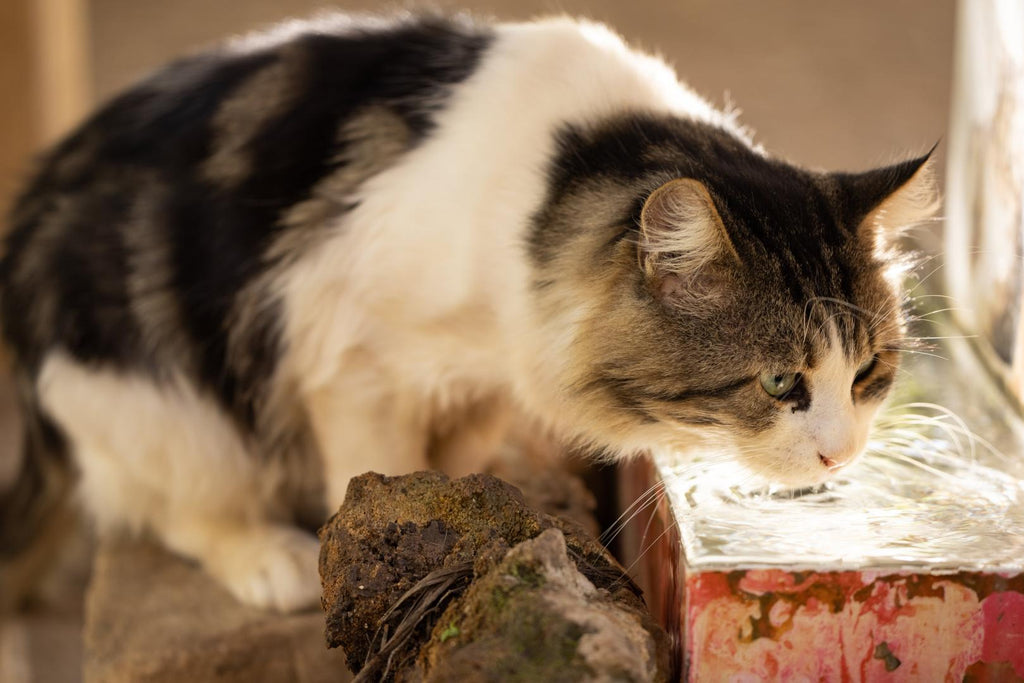Lung Cancer in Cats: Life Expectancy, Causes, and Treatment
Having your feline companion diagnosed with lung cancer by a veterinary oncologist is devastating, especially when it is accompanied by a poor prognosis. It is one of the most serious problems that can affect your cat's health.
We here at Zumalka put together this article to get you in on the important things you need to know about lung cancer in felines so you can properly plan out your next steps.
In this blog post, we won't just be walking you through the finer details of lung tumors and lung cancers in cats, but also give you an overview of the risk factors involved, the clinical signs to keep an eye on as well as the treatment options that you can go for.
As a bonus, we're also going to reveal a premium natural product that you can use to support your kitty when it comes to the treatment of cancer and lung tumors in cats. Besides being non-invasive, it is also designed to maintain your cat's quality of life during this health crisis.
This article will give you all the practical tools you need to handle your pet’s diagnosis.
For a comprehensive look at cancers affecting cats, check out our complete guide to cat cancer for more information.
What Is Lung Cancer in Cats?

Feline lung cancer is a type of cancer that is rare in cats. It is similarly quite uncommon in most dogs as well.
It significantly affects the respiratory system of felines and certain procedures should be conducted to get a definitive diagnosis.
Most primary lung tumors are often deemed as few far and between. It is much more common for cats to develop a tumor in the lungs after cancer has spread from another location than for the tumor to start in the lungs.
Depending on the circumstances and the extent of damage in the lung tissue, there may be solitary tumors or multiple tumors.
This is also the case for squamous cell carcinoma and cancers affecting other organs and parts of the body like fibrosarcoma, the breasts, lymphoma, ceruminous adenoma, brain tumors, as well as those targeting the bones.
But the thing is the tumors that start in the lungs (technically referred to as primary lung tumors), nearly 80% of them are cancerous. This simply means that if a cat has a primary lung tumor, it is highly likely that it will develop into lung cancer sooner or later.
A quick look at how lung cancer develops in cats

At its simplest, cat lung cancer begins when abnormal cells multiply and cause genetic damage over time.
This results in the formation of a lung tumor, which can either be classified as "primary lung tumors" or "secondary lung tumors." The latter is often the result of a metastatic disease when it comes to lung cancer in felines.
We will differentiate the two as we go along.
However, regardless of whether it is primary or secondary, thorough physical examination and other procedures (such as computed tomography and abdominal ultrasound) have to be done to get a definitive diagnosis.
Possible Causes of Lung Cancer in Cats

It is difficult to identify a singular reason why a cat has developed lung cancer. What we do know though, is that older cats and Persian cats tend to develop this cancer more frequently. And like in humans, cigarette smoke is a risk factor, too.
We've outlined some of the most possible triggers that can lead to the development of lung cancer in your pet's body below:
Age
Although there is no average age as regards the development of cancers and tumors in cats, they typically affect felines that are in their older or senior years. This is because beyond adult cats often have a weakened overall immune system health.
This is the reason why boosting your cat's immune health as early as now is essential to make him ideally resilient to disease and illness.
Genetic predisposition
If we're being honest, all cat breeds are vulnerable to cancer. But there are specific breeds that seem to be prone to this serious health concern compared to others, namely the Siamese, Bengal, and Persian.
Your pet's susceptibility to primary lung cancer will also increase if either of his parents were diagnosed with the same, too.
Underlying health conditions
While an underlying cause, such as diabetes, heart disease, or kidney issue won't directly cause the development of either tumor type or cancer of the lung in cats, they can significantly negatively affect your pet's immune response.
Again, providing your cat with a proper immune system booster can help keep these health problems in check.
Exposure to harmful chemicals
Akin to humans, cancer cells tend to get in the picture when a feline is constantly exposed to chemicals that can have a toxic effect on his lungs. These include emissions from vapes, smoke from cigarettes and cigars, as well as harsh household chemicals like oven cleaners and bleaches.
Decreased immune system health
Sure this may sound repetitive, but a poor immune system health can severely increase your cat's risk of cancer in the long run. Just to emphasize, cats whose immune systems are in tiptop shape generally have the best prognosis when it comes to tumor and cancer cases.
What are the Symptoms of Lung Cancer In Cats?

It’s important to know the signs of lung cancer in cats so you know when to get proper treatment and support (or perhaps palliative care) for the same. This is also crucial for the administration of the appropriate symptom management.
Here are some of the most common symptoms to watch out for in the context of feline lung tumor and cancer:
-
Difficulty breathing or sudden rapid breathing
-
Reduced exercise or unexpected exercise intolerance
-
Wheezing or coughing
-
Pleural effusion (or fluid accumulation in the lungs)
-
Poor appetite or severely decreased appetite
-
Weight loss
-
Lumps and bumps that are causing swelling in the chest cavity
While not all of these symptoms point to lung tumors in cats, you should get your cat checked out if you notice any of these symptoms! The earlier any sickness is diagnosed and treated, the better the outcomes generally are.
What's alarming, though, is that not all cats show symptoms when they have lung tumors or cancer. They may only show significant physical changes like weight loss. Technical procedures like CT scans may be required.
Keep in mind that while lung cancer is rare in cats, its effects can be extremely detrimental to your kitty's quality of life if neglected. Regular checkups with your vet are important to keep tabs on your pet’s health.
Conventional Procedures in Determining the Presence of Feline Lung Cancer

Several procedures are used to determine the existence of lung tumors in cats. Whether it's getting a fix on primary lung tumors or metastatic lung tumors, the following are the usual procedures administered:
Physical examination
This is perhaps the most non-invasive diagnostic method used to check for lung cancer in felines. To describe this in a very straightforward sense, it generally involves a physical exam where the chest and neighboring areas will be checked for suspicious lumps and bumps. Chest X-rays are also going to be used for further analysis.
Fine needle aspiration (FNA)
In this procedure, a fine needle is inserted into a bump or lump to extract fluid and cells. These will be subsequently tested for primary lung tumors or their secondary counterparts. It may also be resorted to in cases of lung digit syndrome. This procedure is also referred to as "fine needle biopsy." General anesthesia may or may not be used.
Complete blood count (CBC)
Blood is extracted from the affected area or areas to monitor the presence of tumor markers. This can be also performed before, during, or after a conventional treatment like radiation therapy or chemotherapy.
Chest X-ray
Also technically called "chest radiographs," chest X-rays are used to check for anomalies in the areas covered by the respiratory system, which can include tumors and cancer. It can be also used in conjunction with other procedures to check for other symptoms.
Imaging or digital means
A computed tomography (CT) scan or CT scan is utilized to generate digital internal "photographs" of the chest and other affected areas. CT scans are often performed by trained professionals using high-tech medical equipment.
What are Primary Lung Tumors?

Primary lung tumors are a class of tumors that originate in the lungs and will not spread to other organs when they develop or grow. This type of tumor may progress to primary lung cancer in some cats.
Are they the same as primary lung cancer?
No, primary lung cancer is the proliferation of abnormal cells. A tumor is usually indicated by neoplasms, bumps, or lumps. The recommended treatment for either health concern is also different.
Distinction from secondary lung cancer
Secondary lung cancer in cats is the result of metastatic cancer from a different part of the body that subsequently spreads to the lungs. A metastatic lung cancer may have originated from other organs like the pancreas and breasts, or perhaps the bones.
What are Metastatic Lung Tumors?
Metastatic lung tumors are tumors that originate from a different part of the body and then spread to the lungs. This type of tumor often results in the development or formation of multiple tumors. The recommended treatment may be entirely different from that of metastatic lung cancer.
Conventional cancer treatment usually involves procedures like radiation therapy and chemotherapy.
Lung Cancer In Cats: Life Expectancy

The life expectancy of lung cancer in cats depends a lot on the severity and spread of the cancer, but it is generally less than one year. Sadly, more than half of cats diagnosed with lung cancer have metastasized, meaning the tumors have spread to other parts of the body.
In the later stages, this cancer often spreads to the nearby lymph nodes and other areas of the lungs.
Treatment of Feline Lung Cancer
Depending on your cat’s circumstances, your vet might recommend surgery to remove the tumor and affected area. If surgery isn’t possible or if the cancer has spread, they might also recommend chemotherapy.
Conventional Options in Treating Lung Cancer
The most common treatment options for lung cancer in felines are as follows:
Surgical removal
As the name suggests, it involves the invasive procedure of removing the cancer through surgical means. Surgery may also be resorted to in the case of a tumor.
Radiation therapy
Radiation therapy makes use of very intense beams of light to induce cancer cells to die. Interestingly, this type of cancer treatment incorporates X-rays in its administration. Radiation therapy often has nausea, vomiting, and sudden hair loss as side effects.
Chemotherapy
This type of treatment utilizes powerful chemicals to kill off cancer. It can be used in all stages of cancer in felines. However, due to the chemicals involved, your pet will be exposed to adverse side effects like loss of appetite and extreme lethargy.
Recommended Natural Treatment Options for Cat Lung Cancer
It is never easy to make a decision on treatment for your loved pet. What we do know, though, is that you want the best treatment possible! So do we. Many pet parents look for natural remedies that work for many illnesses, including cancer.
We are happy to introduce a natural product that has helped thousands of pets and their owners - PIPTOPET. It has been designed with a medicinal mushroom called Fomitopsis betulina to help your companion during his fight.
Remember that we are always here to provide help and support through your pet’s health concerns.
Please schedule an online consultation right now so we can know how best to help you, or get in touch by phone, email, or web chat any time.
We appreciate the time you take to share this article on social media so others can be helped with this important information too!
Don’t forget to leave a comment too and let us know what health concerns your pet is facing.








Dear Sandra,
We understand your feelings. Our beloved pets teach us more than we could have expected and love us more than we could have hoped…that’s why we miss them more than we could have imagined….
Give yourself time to process your grief and to mourn… but don’t forget: the highest tribute to our departed ones is not grief but gratitude…
We are with you in these dark moments!
Please help me.
I had to say goodbye to my 13 yr old cat yesterday who had lung cancer. I am tortured by thinking my delay in taking her to the vet when I noticed she had lost weight and then when I discovered a tiny lump just under her jaw line instead of taking her straight to the vet instead I kept an eye on it for a week. It got a little bit bigger but then didnt grow any further. It didnt appear to be painful it was soft, oval and moved around a bit when I touched it. It was then I decided to take her to see her vet but unfortunately it was not her usual vet as he wasnt available but i didn’t want to wait. The vet said it was a swollen lymph node and prescribed pain killers. But after 3 days it was obvious not all was well so I made another appointment with my usual vet who said he didn’t think it was lymph node but felt like a few soft nodules together but couldnt say exactly what it was. So he immediately did blood work which showed elevated calcium levels. He then did an xray and said her lungs looked like cotton wool and sadly diagnosed cancer. But to be sure he sent the xrays to a specialist in oncology who whilst saying it could be a traumatic infection, in his opinion, he would tend to concur with the cancer diagnosis.
Flossie went downhill within a few days and finally we said goodbye within 1 week of diagnosis.
I am devastated, as we live in the countryside and we don’t smoke and she has lived a healthy lifestyle so I never considered she would get lung cancer. Plus it seemed one day she was running around the next seriously ill. Was it cancer, did they get it wrong? Could she have been saved? Why didn’t I take her earlier. Were the foods i was offering to get her to eat not good enough. Why did she suddenly eat cat yoghurt and want to go outside the day before she passed. And worse of all , why did she cry out loud in the vets for no reason. She was a quiet cat and I’d never heard her shout like that
Were those lumps the cause of her cancer and if I’d taken her when I first felt it could it have been removed and would it have stopped her getting lung cancer?
The torture and torment I have over all these questions and my failure to take her to the vet sooner is consuming me. I have had many rescue cats and with Flossie I currently had 3 sisters. I have always been fastidious in keeping an eye on them to the point of obsessive. But on this occasion because Flossie has always been a small cat compared with her sisters, when I mentioned my concerns of weight to loss to my husband I accepted it when he said she’s always been a slight cat and that i was being overly sensitive. So I delayed. Now I’ve lost my beautiful girl and the guilt is destroying me. I am a scientist by degree, ( microbiology,,) so I have used my training to try to research if my delay was enough to allow metastases to occur in her lungs ( if thats the right term) from the soft lump in her neck.
I don’t know if her neck lumps were benign or malignant tumours nor do I know if it was primary or secondary lung cancer. I just know i feel so much guilt on my delay which was so uncharacteristic of me. I’m not looking for forgiveness as the delay was unacceptable and I will need to live with that guilt forever but im just looking for answers of why and how and did my delay affect the outcome.
Why did this happen to my beautiful fur baby and why was I so stupid.
Hi Ana,
We sent you an email. Let us know how else we can help.
My cat is diagnosed with a mass that ocupied all left lung.
Is pitopet able to help in this situation.
How isit applied?
Leave a comment